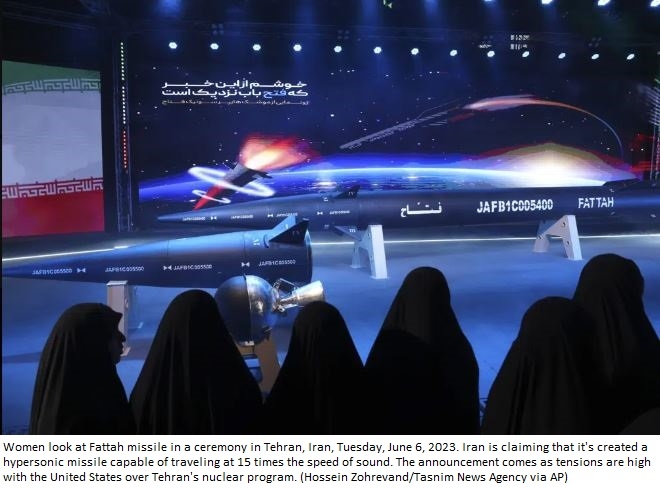Iran Unveils Hypersonic Missile Amid Tensions, Claims Superiority in the Region

Iran has announced the development of a hypersonic missile named Fattah, capable of reaching speeds 15 times faster than the speed of sound, according to state media reports on Tuesday. The unveiling of this new weapon comes at a time of heightened tensions between Iran and the United States over Tehran's nuclear program. The missile's introduction is seen as a demonstration of Iran's military capabilities and its ability to deploy advanced weaponry against its adversaries in the Middle East.
During the tightly choreographed segment on Iranian state television, President Ebrahim Raisi emphasized the significance of this new weapon, stating that it has created a deterrent power, providing lasting security and peace for regional countries. Gen. Amir Ali Hajizadeh, the head of the paramilitary Revolutionary Guard's aerospace program, presented what appeared to be a model of the hypersonic missile. He claimed that the missile has a range of up to 1,400 kilometers (870 miles), which falls within the mid-range of Iran's existing ballistic missile arsenal.
While Iran's ballistic missiles have been a cause of concern for regional security, the maneuverability of the Fattah missile remains a critical factor in assessing its effectiveness. Tuesday's presentation revealed a moveable nozzle, suggesting the potential for trajectory changes during flight. Such maneuverability makes it more challenging for anti-missile systems like the Patriot to intercept the missile, as its irregular flight path becomes harder to predict. However, Iranian officials did not provide video evidence of the Fattah successfully launching and hitting a target, raising questions about its operational capability.
Hypersonic weapons, flying at speeds exceeding Mach 5 (five times the speed of sound), pose significant challenges for missile defense systems due to their speed and agility. China and the United States are believed to be pursuing hypersonic technology, while Russia claims to have already deployed such weapons, even allegedly using them in the conflict in Ukraine. However, the ability to reach high speeds and change trajectories does not guarantee successful target strikes. In May, Ukraine's air force reported shooting down a Russian hypersonic Kinzhal missile using a Patriot battery.
Gulf Arab countries, aligned with the United States, heavily rely on the Patriot missile system for regional defense, and Israel maintains robust air defenses as Iran's main regional rival. The introduction of Iran's hypersonic missile raises concerns among these nations and their defensive capabilities.
It is worth noting that this is not the first time Iran has claimed the development of a hypersonic missile. Last November, Gen. Hajizadeh made similar claims, but without providing any supporting evidence. The timing of Tuesday's announcement coincides with U.S. Secretary of State Antony Blinken's visit to Saudi Arabia, adding another layer of complexity to the regional dynamics.
As tensions persist between Iran and the United States, the unveiling of the Fattah hypersonic missile highlights Iran's ongoing efforts to enhance its military capabilities and establish itself as a regional power. The international community will closely monitor further developments regarding Iran's claims and the implications they may have on the region's security and stability.














